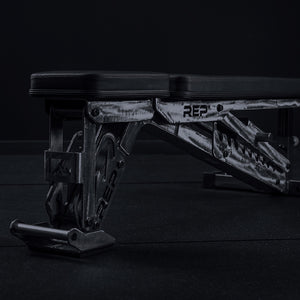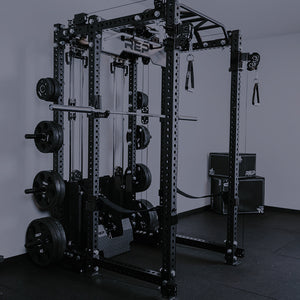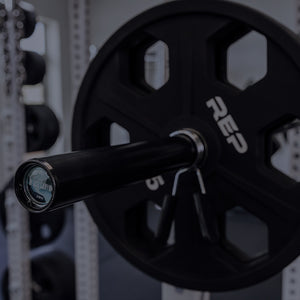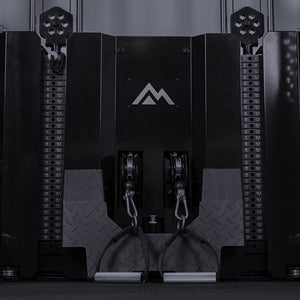
Don’t be intimidated by these weirdos. Specialty barbells will help you get yoked as heck.
In a world of straight barbells, these guys look different. Some are curvier or thicc. Some have handles or pads or all kinds of different grip angles that can look confusing to use – even if you’re not new to the gym. But there are two things these specialty bars all have in common: They all have metal, loadable sleeves you can stack weight plates onto. And they’ll all help you get yoked as heck.
Here’s a closer look at seven popular specialty barbells: what they are, how to use them, and why you want to.
REP® Specialty Bars
Regardless of the type of work you're looking to tackle in the weight room, REP has you covered with the right bar to get the job done. Here are our most popular options:
Safety Squat Bar
What it is: The Safety Squat Bar has cambered ends and handles that bring your hands in front of your body, rather than out to your sides like a straight barbell.
How to use it: Back squats are the most common use for a safety squat bar, but you can do a ton more: overhead presses, skull crushers, calf raises, you name it. Check out this article for more exercise ideas.
Why use it: Use it for a wide variety of exercises; a different challenge (it sits higher on your shoulders and the camber drops the weight below bar height); and comfort. It reduces stress on your elbows, shoulders, and wrists, making it great for people with limited shoulder mobility who find straight bar squatting uncomfortable. It helps squat form by improving your ability to remain upright, while also training your midline more. It can also help preserve your upper body strength on leg days.
Learn more about the Safety Squat Bar here.
Cambered Swiss Bar
What it is: The Swiss bar has a ladder-like design in the middle with angled rungs to create various grip options. REP’s Swiss bar also features a cambered design, and the outermost handle is set at a deficit.
How to use it: The Swiss bar is best known as a bench press accessory/alternative, but it can also be used for lat pull-downs, seal rows, ab rollouts, front squats, hammer curls, triceps extensions, and a ton more.
Why use it: It’s great for a wide variety of exercises and a greater range of motion due to the cambered design. Neutral-grip variations are gentler on the shoulders when benching. The arch also offsets the weight from your grip, creating a pendulum effect, so you must engage more muscles to stabilize the bar, creating a different stimulus than a traditional barbell.
Learn more about the Cambered Swiss Bar here.
Curl Bar
How to use it: The Curl Bar is (go figure) specifically designed for biceps curls (from preacher curls to reverse curls), although you can also use it for skull crushers, overhead triceps extensions, and more. You could also use it for close grip chest presses or upright rows, although many people prefer to use the Curl Bar for exercises that target smaller muscle groups, like arms.
Why use it: The bent shaft reduces joint strain. The bends allow for a semi-supinated grip, which limits the stress on wrists and elbows.
Learn more about the Curl Bar here.
Rackable Curl Bar

What it is: This is like the Curl Bar (EZ bar) with a bent shaft, except it weighs more (35lbs) and is longer (6’2”) -- long enough to rack in a standard-width power rack.
How to use it: Use the Rackable Curl Bar in all the same ways as the standard Curl Bar. The ability to rack it makes it easier to load the sleeves with plates and more comfortable to get into position for your lifts.
Why use it: The semi-supinated grip limits stress on wrists and elbows, reducing common injury risk.
Learn more about the Rackable Curl Bar here.
Trap Bar
What it is: This hexagonal-shaped bar (also called a “hex bar”) allows for the equal distribution of weight around the body, instead of just in front like a regular deadlift. The bar features dual handles (standard and raised).
How to use it: It's typically used as a deadlift alternative. You can also use it for bent-over rows, frame carries, push-ups, Romanian deadlifts, and even kneeling shoulder presses, floor presses, and more.
Why use it: When used for trap bar deadlifts, the Trap Bar reduces stress and tension on the lumbar spine and can improve the efficiency and technique of deadlifts. It can also help people rehabbing from an injury or for lifters with a limited range of motion. The Trap Bar is more quad-dominant than conventional deadlifts, making it a great alternative for people who can’t do full-depth squats but still want a good quad workout from a compound movement.
Learn more about the Trap Bar here.
Open Trap Bar
What is it: This is similar to a Trap Bar, except its open design allows for a versatile range of movements, like squats, lunges, and presses.
How to use it: Like a Trap bar, this places the weight directly in line with your center of gravity instead of in front like a straight barbell. You can also use this bar for pressing and squatting, and you can swap out the handles for various widths and styles (rotating) for different challenges.
Why use it: There are a ton of reasons to use an Open Trap Bar. Here are 13 benefits of an open trap bar.
Learn more about the Open Trap Bar here.
Axle Bar

What it is: An Axle Bar is thicker, shorter (5’ or 7’ long), and lighter (17lbs or 22lbs) than a standard barbell. It has no knurling and the sleeves do not rotate.
How to use it: The Axle Bar is a Strongman and grip sport staple. Use this in all the ways you would use a regular barbell, but it’s especially great for pulls.
Why use it: Added challenge. The thick, 2” diameter is harder to hold and can strengthen your wrists and grip. Grip strength is related to stronger forearms and shoulder stability. This can translate into improved lifts on a standard barbell (because after pulling a fat bar, the regular barbell will feel like cake). The thicker bar also eliminates bar whip, so when doing heavier deadlifts, you feel all the weight right off the floor.
Learn more about the Axle Bar here.
Farmer's Walk Handles
What it is: Two barbells with elevated handles. Farmer’s handles allow you to do weighted carries, which are essential to a functional fitness program.
How to use it: Load the sleeves with plates, grab the handles, and pick them up. Keep your hands by your sides, your shoulders engaged, and back straight. It’s common to then walk a set distance with the weight. Tip: Short, fast steps are most effective. You can also do suitcase carries. Farmer’s walks are commonly seen in Strongman.
Why use it: Farmer’s carries improve your grip, endurance, and overall strength. They work a ton of muscles all at once, like legs, glutes, lats, traps, abs, and upper back – and they especially challenge core stability.
Learn more about Farmer’s Walk Handles here.
Hades ™ Deadlift Bar 
What it is: A specialty barbell designed just for deadlifts. It's longer, thinner, with more bend, and more aggressive knurling – but no center knurling.
How to use it: Just like a regular barbell, except this is for deadlifts. You’ll notice deeper knurl for maximum grip assistance, and pulling a deadlift bar feels slightly different (especially with heavier weight) because the bar bends earlier, allowing you to gain momentum and speed before the plates even break the floor.
Why use it: Some associations (like the USPA, IPL, or WRPF) use a deadlift bar in comp. Many lifters can pull more weight with a deadlift bar. People with smaller hands will appreciate the thinner shaft. Even if you don’t compete, many lifters just enjoy pulling with this barbell.
Learn more about the Hades™ bar here.
Helios ™ Squat Bar
What it is: A bar made just for squats. A squat bar is longer, heavier, wider, and is fully knurled.
How to use it: Use the middle knurl mark to center the squat bar on your back and squat away.
Why use it: Some powerlifting associations use a squat bar (such as the WRPF, UPA, APF, APA, and IPL), typically just for heavier lifts. The longer length prevents the weight plates from hitting the power rack uprights while racking or unracking the bar. This also allows you to position your hands outside the rack uprights. The thicker diameter adds rigidity to the bar and minimizes whip/flex during heavy loads for a more stable squat. The full knurling ensures maximum points of grip on your back, rear delts, and traps to create a secure connection.
Learn more about the Helios ™ bar here.
Colorado™ Short Bar

What is it: The Colorado™ short bar is a compact Olympic barbell designed for versatile strength training. With a length of 6' and weighing 25lbs, it features a 28.5mm diameter, multi-grip knurling, and a hard chrome finish, making it durable and suitable for smaller spaces.
How to use it: Use the Colorado™ short bar for a wide range of exercises, including bench presses, squats, deadlifts, and rows. Its shorter length makes it ideal for home gyms, smaller workout areas, or functional training setups.
Why use it: Choose the Colorado™ Short Bar for its space-saving design without sacrificing performance. It's perfect for lifters of all levels who want a versatile, quality barbell for strength training in a limited space.
Learn more about the Colorado™ Short Bar here: REP Fitness Colorado™ Short Bar
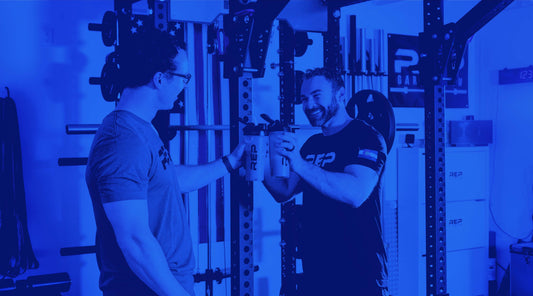
NEWSLETTER SIGNUP
Product launch information, promotions, blogs, and REP news.

